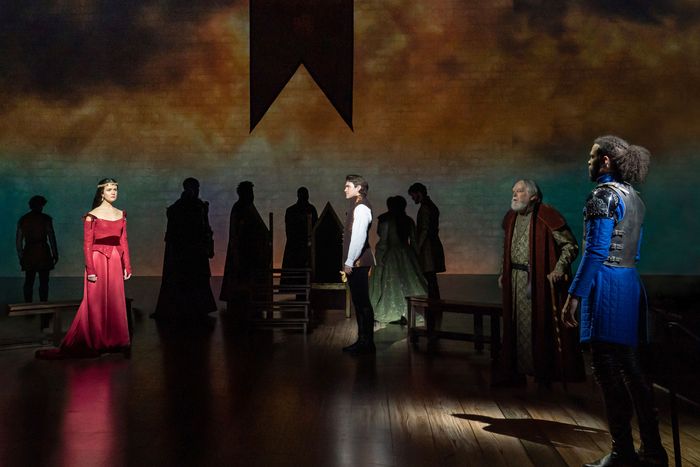
Camelot always looks better in hindsight. Lerner and Loewe’s musicalization of Arthurian legend, itself based on T.H. White’s The Once and Future King, first made it to Broadway in 1960 after a rocky out-of-town tryout. In Toronto, Lerner developed an ulcer, and director Moss Hart had a heart attack from which he never fully recovered. By the time they cut it down (from more than four hours) and got it to Broadway, reviews were mixed — the Times called it “partly enchanted” — and ticket sales picked up once Lerner and Loewe showcased a few songs on an Ed Sullivan Show episode. Camelot ascended into the canon well after the Broadway run ended in January 1963, thanks in large part to a Jackie Kennedy interview in Life after her husband’s assassination that conflated Camelot with the Kennedy dynasty and cannily melded JFK’s image with the show’s heroic, democratizing vision of King Arthur. Staging Camelot now means you have to tackle the show as it exists — a somewhat awkward epic with brilliant moments — and address its hazy nostalgic one-brief-shining-moment mythos. Enter Aaron Sorkin.
Lincoln Center Theater’s production, directed by Bartlett Sher, is better on the latter front than the former. Its reconstructed book by Sorkin haphazardly drags the musical closer to reality, but it’s in its biggest, grandest gestures where the revival succeeds. Sorkin, a screenwriter known for the walk-and-talk of The West Wing and A Few Good Men, has lately returned to the stage with To Kill a Mockingbird, but this is the first time he’s putting his BFA in musical theater to use (and learning that he has a BFA in musical theater helped me understand why his TV shows have so many Gilbert and Sullivan jokes). He’s unsurprisingly drawn to the politics of Camelot, and he remains too quippy for his own good. He’s eliminated the magical elements from Lerner’s book — the sorceress Morgan Le Fey is now a woman in STEM — and instead put the emphasis on nation-building. Things are vaguely set in the 14th century, with a version of Arthur who isn’t sure whether he’s gotten divine authority from pulling that sword out of that stone or, as his wife, Guenevere, suggests, just because thousands of other men loosened it before him. The broad strokes of Sorkin’s changes work: You see Arthur-as-Kennedy-esque-reformer very clearly (also, floppy-haired Andrew Burnap, playing him, looks straight out of Hyannis Port). There’s something to Sorkin’s exploration of the couple’s political-yet-loving marriage, with a new exchange near the finale that’s Sorkin at his most romantic. You don’t miss the magic much, though the stubs where it’s been lopped off are obvious. When Lancelot fells Arthur in the tournament (Sorkin has him step in for one of the knights once he realizes Guenevere’s interest in Lancelot), everyone keeps talking about how the French knight miraculously revived the king from the dead, while Arthur insists he just passed out for a bit because of a bad head wound.
Yet Sorkin falters on — of all things — the dialogue. The characters all sound too much like everyone on Sports Night: relentlessly talky and prone to predictable rhythms of patter, deflating the grandeur of the setting. Sher conjures a beautiful opening tableau of Arthur’s men standing in the snow waiting for Guenevere’s carriage to arrive and then Sorkin provides some annoyingly colloquial banter among them, with one muttering to another, “I have the exact same amount of information that you do!” When Arthur first sings the title song to Guenevere, she makes fun of him for emphasizing the nice climate of a place in England. He says it’s a metaphor. She says she knows what a metaphor is. Etc. Later on, they bicker about his referring to her as a “business partner,” a phrase that punts you right out of the Middle Ages, unless these two are involved in the Hanseatic League. I admit I’ve never been a fan of Sorkin’s ping-pong witticisms, but the problem with the dialogue goes beyond taste. Sorkin mistrusts the audience’s ability to follow a story told in a fanciful tenor, so he keeps puncturing its majesty. Humor that leans against the fourth wall of a show is fine in small amounts. It might even work if Arthur were the only one who kept pointing out that these circumstances are a bit silly while his court remained more serious. But the accumulation of “so … that happened”–style jokes starts destabilizing its load-bearing columns.
Luckily, Camelot has the Gothic flying buttresses of its songs to keep its structure sound. Loewe’s melodies are some of his most irresistible — take your choice of an earworm, from the melancholy pomp of “Camelot” to the smoldering ember of “If Ever I Would Leave You” — and Lincoln Center’s orchestra, all 30 players of it, weaves a sumptuous tapestry of accompaniment. Jordan Donica, a Lancelot who seems to stand a foot taller than everyone else onstage, has an especially gorgeous and powerful baritone, such that it’s easy to imagine falling for him as Phillipa Soo’s Guenevere does. Soo is sprinting through young royal sopranos after playing Cinderella in Into the Woods, and here she wisely chooses to emphasize Guenevere’s sexuality and slyness, especially in her rousing “Lusty Month of May.” Sorkin has only irregularly been a great writer of women, and he’s reverted to an old white-glove approach to Guenevere, putting her on a pedestal, so it’s to Soo’s credit that she finds a believably conflicted and compelling person to play within his text. She brings heat to her scenes with Donica’s Lancelot and then bookish enthusiasm mixed with wistful disappointment to those with Arthur. Burnap doesn’t have a voice near the level of Soo’s or Donica’s, and even though Arthur isn’t a part that asks for power, you can hear his effortful trying to keep up. Still, like Arthur, he ekes his way there, and his and Soo’s version of “What Do the Simple Folk Do?” — itself preceded by too much chatter fretting over whether calling people “simple folk” is classist — has a lovely, human-scale charm.
The performances owe a lot to Sher, who has made himself a go-to resurrector of musical classics, bringing the likes of The King and I and My Fair Lady back with lavish sets and a clear-eyed sense of their core dynamics. Compared to what he’s done previously at the at the Vivian Beaumont, Camelot is relatively restrained: Michael Yeargan’s set situates the action under churchlike stonework but is often more bare than not, with a significant amount of watercolor-style projection (by 59 Productions) at the back. Still, we get one striking gesture after another, like Lancelot climbing up onstage in front of a sunrise or that tense jousting-tournament duel. Jennifer Moeller’s meticulously textured armor and gowns help a lot; the group scenes are often an opportunity just to admire good stitching.
If Sorkin thinks we’ll get these characters only if they come down to our reality, Sher knows to veer into the logic of fairy tales to make the emotion work. In the second act, trouble arrives via Arthur’s illegitimate son, Mordred (Taylor Trensch, in demon-twink mode), who contrives to catch Guenevere and Lancelot together and to set Arthur’s knight’s against him by playing to their selfishness. Mordred rallies the knights over the course of “Fie on Goodness,” while Sher transitions between scenes of Arthur and Morgan and Guenevere and Lancelot. The motion onstage is so effectively managed that the logic of Mordred’s plot (a faked letter in lieu of spellcasting) goes down easy. No need to have someone comment on the heightened dynamics at play when you just elevate the audience into a heightened reality.
It’s to Camelot’s advantage, then, that it ends in the mythic realm. About two hours and 45 minutes in, we get to the reprise of the title song that Jackie famously quoted, with Arthur off at war against the French, instructing a young boy to leave the front and go carry on the glorious memory of what he attempted with the Round Table — “Before you drift to sleep upon your cot / Think back on all the tales that you remember,” etc. No matter how you stage it, the moment is cheesy, but it’s got a magnetic power, something buried in the way the lilting melody is transfigured into a martial dirge. It convinces you you’ve seen something greater than you have, makes you believe in the dreams for a kingdom Arthur didn’t realize. That’s the trick of Camelot, too, as a show. I can enumerate all its flaws, of which there are many, and yet the possibility of it all sticks in memory. The revival makes you want to believe in a great musical called Camelot, even if such a thing never did exist.
Camelot is at the Vivian Beaumont Theatre.





